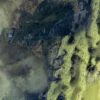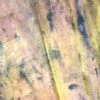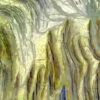When I was growing up, the nearby wood loomed on the horizon, a domed, multi-tentacled thing, dropped upon an orderly patchwork of ploughed fields and tightly boxed hedgerows. It appeared to be an interloper in the English lowlands when the surrounding farmland was actually the conquering force.
Back then, Foxley was three miles from my boyhood home. It was our local wood, and another world. We used to go there in autumn for the fungi and falling leaves and in spring for the carpet of bluebells. But most exciting was high summer, when it drew a leaved curtain over itself and Dad and I would go in search of the purple emperor.
‘[T]hat dark prince, the oakwood haunting thing / Dyed with blue burnish like the mallard’s wing’ – John Masefield’s poem soared through my dreams as a boy. If I rested my pictorial guide to British butterflies on its spine, the pages fell open at the emperor. A photograph showed the male of the species, perched on a spray of oak, wings pointed like a shark’s fin, shimmering iridescent purple. This spirit of the woods has captivated generations of naturalists but it bewitched me because it was not there.
The distribution map in my 1980s field guide showed blotches of red over Hampshire, Surrey, West Sussex, Oxfordshire and Buckinghamshire where the emperor flew. The rest of Britain, including our county, Norfolk, was white with the butterfly’s absence. The purple emperor was understood to be a ‘woodland’ butterfly, and the red dots correlated with native broadleaved woodlands, places characterised by deciduous trees such as oak, ash, beech, elm and lime that had recolonised Britain after the last ice age. In most parts, such woods survived in pitiful fragments, remnants – it’s widely believed – of the primordial forest that once covered our landscape. The emperor was rare, we thought then, because its kingdom had been decimated.
In the heart of Norfolk, Foxley had endured at just over 300 acres, the same size as a modest Norfolk family farm, for centuries. From the air, its square of forested land with a rectangular bite removed from one side was such an aberration – so dark and distinctive – that RAF pilots used it to navigate. This scrap was Norfolk’s largest ‘ancient woodland’, defined as continually forested since at least 1600. But Foxley was far older than that. Its heavy clay soil was not easily cultivated and its trees had probably never been clear-felled. Certainly, by the Domesday Book of 1086 Foxley was a distinct wood, a place where domesticated pigs were released for ‘pannage’ to fatten up on fallen acorns. In the early Middle Ages it was managed as a deer park; later it was coppiced. Coppicing was first recorded in the Bronze Age, and involves the regular cutting back of trees and shrubs, such as oak, ash, willow, field maple, sweet chestnut and hazel, down to their base to stimulate the growth of multiple stems in place of a single large trunk – strong, flexible ‘rods’ that were used for making hurdles, stakes, tool handles, baskets and poles. Bigger ‘standard’ trees would be saved as timber for buildings and ships. As an indicator of its antiquity, Foxley contained both wild service trees and small-leaved limes, once-common native trees that became increasingly rare over the centuries because they were of no commercial value.
During the twentieth century, as the purple emperor vanished from East Anglia, Foxley became its last hiding place. One was spotted dashing through the wood in 1971. By my 80s childhood, the emperor was extinct in Norfolk. Or was it? I hoped, despite my field guide’s pessimism, that it was possible the emperor could reside there.
In theory, Foxley offered this notoriously tricksy insect its ideal habitat: sallow (wild willow) and oak trees. Males took territorial positions high in prominent oaks like resting big cats, only emerging for percussive aerial engagements with fellow males for the possession of females but also with perceived ‘rivals’ such as dragonflies, blue tits and even passing kestrels or hobbies. Females, which lack the iridescent purple, skulked unseen in sallow, where they laid eggs and their caterpillars fed.
If such a creature was still hiding in Foxley, I knew it would be hard to spot. The emperor did not deign to descend from its ethereal realm to sip from flowers like an ordinary butterfly but, if undisturbed, might settle to probe for the minerals found in fox scat, muddy puddles and other execrable treats. Ordinarily, it moved so fast that most might only glimpse a dark silhouette as it flashed high across a forest ride.
Every July in the 80s, Dad and I parked on the lane outside the wood and entered via a new Forestry Commission ride, a broad grassy track that provided access to a recent conifer plantation. Foxley cocooned us from the outside world, swallowing all sight and sound of the conventional countryside. Dad, an environmental scientist, explained how this was once a bewilderingly diverse place. He had produced a diagram of Foxley’s compartments in the 1970s: oak, bracken and bluebells; oak and larch; birch and brambles; alder coppice; lime coppice; aspen-ash-hazel coppice. Back then, each section had its own scent, he said, each its own distinctive sound. By the 1980s, however, Foxley had been corralled into two simplified woods: an old wood mostly made up of what foresters call ‘derelict’ coppice, and a new conifer plantation of tightly packed neatly rowed ranks of lodgepole pine from the American Northwest, grand fir from northern California, spruce from Norway and Scots pine from Europe. This global, industrial wood was dark and silent, and not just in midsummer. Its silence was not the cocooning of the trees but of obliteration – no birds singing, no insects humming, not even the clap of a wood pigeon’s wings.
We would turn left, into the overgrown coppice, where the grassy ride narrowed. Hazel ballooned beneath larger oak ‘standards’ although even then grand oaks had long since been removed. In midsummer, the woodland floor was a gloomy carpet of dog’s mercury: my dad had measured the light levels here and found them to be 3 per cent of those in the open air. Honeysuckle threw plaited ropes like Rapunzel’s hair through the darkness, although its vitality was dwindling. It used to be so thick that a forester who worked in the wood told me it had once twined around the axle of a tractor being driven through the trees and held it fast. Coppicing had ceased in Foxley, the canopy had closed in, and we admired the white admirals that glided past, the only butterfly that tolerated such crepuscular summer conditions. Of the emperor, there was no trace.
Foxley Wood may have been at least 1,000 years old and the largest ancient woodland in Norfolk but it was a wholly unexceptional memorial to an age of extinction – its declining diversity a fate shared by almost all ancient woodlands in Britain.
I had always been told that the purple emperor was rare because old woods were rare. In the last century, they had vanished, alongside many other insects, plants and birds, because of the loss of the traditional coppicing practices that created light, dappled shade and complex, varied habitats. Before coppicing, however, how did all these species survive? What did the original ‘wildwood’ look like? The dark, enclosed forest of our imaginings may be far from the landscape that prevailed in Britain before humans made an impression. The idea that, say, a purple emperor could have once flown from Land’s End to John o’Groats over an unceasing canopy of trees is debunked by Oliver Rackham, the pre-eminent chronicler of British woodlands. ‘It is debatable whether “virgin forest” or “primaeval forest”, unaffected by mankind, exists anywhere in the world, or whether it is one of those phantoms, like “primitive man”, that haunt the scholarly imagination,’ he wrote.
We no longer believe that dense woodland was once the natural state. Before humans reshaped the land, trees were constantly disrupted by storms, landslides on steep hillsides, diseases and insect infestations, as well as by the browsing and disturbance of wild herbivores. Dutch ecologist Frans Vera, the author of Grazing Ecology and Forest History, has repopulated historic landscapes with armies of aurochs (wild cattle), tarpans (wild horses), bison, boar, beavers and deer that would have browsed on leaves, shoots and emerging saplings, brought down mature trees by gnawing their bark, and snapped off their branches. These animals were the first to coppice our woods; their actions were why our native trees responded so well to our axes and billhooks. Their disturbance would have created a more open treescape, a mosaic of wood pasture with giant trees, grazing ‘lawns’, groves and thickets of scrub; where no clear boundary existed between wood and wider countryside.
That the purple emperor is traditionally viewed as a creature of ancient oak woodlands, is, according to Matthew Oates, a naturalist who has dedicated his life to the study of this confounding butterfly, because it was in old woodlands that we looked for them. He says the emperor is, essentially, a butterfly of damp clay lands, where grows both pedunculate oak and sallow, its foodplant. The oak requires sunlight, and cannot naturally regenerate in dark woods. Sallow, a fast-growing bushy tree, thrives in damp areas but is shaded out within mature woodland. According to Oates, the emperor’s caterpillars seem to thrive on heterogeneity: of topography, microclimates, and complex varieties of sallow, and sunny and shady conditions. For centuries, this butterfly would have lived outside what we regard as woodland, along riverine landscapes, on commons and on wood pasture, a more open treescape, like the landscapes of the distant past, which combines mature open-grown trees and glades grazed, browsed and disturbed by either wild animals or domesticated livestock.
Old maps show Foxley’s boundaries – fixed by humans – have remained unchanged over the centuries. Its shape on a 1797 map is almost identical to today. What has been transformed since then is the surrounding land. The 1797 map depicts vast commons and open field systems. Enclosure – consolidating village farmland into individual, private farms – caused the loss of huge areas of communal grazing. In earlier times, sallow branches had many uses, not only as rods in medieval wattle and daub walls but as spring fodder for cattle before the grass began to grow. As farming intensified following enclosure, overgrown hedges, boggy scraps of woodland and other sallow-rich habitats convivial for the emperor were excised. By the twentieth century, the butterfly had retreated to woods where oaks and remnants of sallow managed to cling on.
Once confined there, the emperor was further emasculated by the revolution within British woods. Surveying the sinking of ships importing timber during the First World War, politicians realised that even the coal-fired industrial age required timber for coal-mine pit props and, with barely 10 per cent tree cover, the country was perilously dependent on foreign imports. The Forestry Commission, founded in 1919, grew a strategic reserve of timber on cheap land – heaths, poor farmland and, after the Second World War, ancient woodland. In a rational world, argued Rackham, a woodland would be the last location for a new plantation, requiring the arduous removal of all competing natural trees. He called 1950 to 1975 the ‘locust years’, when native flora and fauna were devoured by politicians’ and foresters’ hunger for monocultures of non-native conifers. At that time, the emperor’s foodplant, sallow, was considered a ‘weed’. Meanwhile, over the same century, coppicing, mimicking the effect of browsing animals, almost died out. Surviving broadleaved woods became dark and denuded of species. Sallow, which had thrived on coppice edges, was shaded out as trees closed in. It was not just the emperor that suffered: sallow is our third most important tree for moths (after birch and oak), supporting 108 moth species.
During this period, Foxley, and most other old woodlands, saw biodiversity disappear. As well as the emperor, Foxley was once home to an abundance of fritillaries. The chequered golden brown butterflies were perfectly adapted to the chiaroscuro light of a woodland in midsummer, their caterpillars feeding on violets which flowered in profusion in the glades created by coppicing. Silver-washed, high brown, dark green, small pearl-bordered and pearl-bordered fritillaries all once bred in Foxley. The last of these was known as ‘the woodman’s friend’ because it so rapidly colonised the sunny glades created by freshly cut coppice. All vanished from Foxley, and hundreds of other British woods, during the twentieth century.
While childhood walks in Foxley were an uncomplicated pleasure for me, for Dad and others who experienced the butterfly-filled glades of the 50s, it was a place of loss. The wood was given a national designation as a Site of Special Scientific Interest in 1954, in theory giving the Nature Conservancy, the government’s conservation watchdog, the power to ensure that it was managed for wildlife. Despite this, Foxley was leased to the Forestry Commission and more than a third was cleared for conifers. Foxley’s old trees were sprayed from the air with 245T, a now-banned herbicide related to the infamous Agent Orange of the Vietnam War. As there was no demand for firewood, all but the largest oaks were dragged into pyres and burned.
Dad moved to Norfolk in the aftermath of this tragedy. In the 1970s, Foxley became a research site for his students and Dad encouraged Norfolk Wildlife Trust (NWT) to buy Foxley. By the 80s, as the new conifers struggled on Foxley’s heavy clays, the Forestry Commission’s lease was returned to its previous owners, who used the wood as a pheasant shoot. NWT tried to acquire it, but the sale was a fraught process. I remember watching Dad on the local television news. He seemed flustered. The report suggested that the owners were being ‘forced’ by conservation bureaucrats to sell their treasured wood. That week at school, the son of Foxley’s gamekeeper said my dad was pushing his dad out of a job; the land-labouring man’s son versus the namby-pamby conservationist’s son. I felt for the first time what most middle-class conservationists are often reminded of: we don’t own the land, nor do we authentically inhabit it as the classes above and below say they do, so how dare we lay claim to it? Dad told me that NWT offered the gamekeeper a job as Foxley’s warden but the gamekeeper decided that working for a conservation charity wasn’t for him. The trust completed the purchase of Foxley in the early 1990s. During that decade, Dad moved away from deforested Norfolk for good. I relocated as well, to university and then to work in big cities. During our absence, over the next two decades, Foxley Wood was transformed.
Coniferisation may have given plantation forestry a bad name among conservationists but we live in a new age of tree planting. Placing a native tree in the soil is an act of beneficence, ‘a ritual of atonement’, wrote Richard Mabey, who is old enough to remember the government-sponsored ‘Plant a Tree in ’73’ campaign. Planting trees is political catnip, an altruistic act and a declaration of faith in the future. Politicians and big businesses are keen to tell the world how many they are planting. Donald Trump shuns global climate accords but in 2020 the American president signed up to 1t.org, the World Economic Forum’s campaign to plant a trillion trees. British prime minister Boris Johnson has been an enthusiastic tree planter since his London mayoral days, when he pledged 10,000 new street trees and planted one by wielding a spade from over his shoulder like a pickaxe. His government’s commitment – to plant 30 million new trees each year – is outbid by every other political party. Labour has promised 2 billion by 2040. (In the year up to March 2019, the country managed approximately 22 million, many of them conifers, mostly in Scotland.) These aspirations are dwarfed by those of other nations. Ethiopia claims to have planted 353 million in one day in 2019. The Chinese government says it has planted more than 66 billion new trees in the country’s north since its Great Green Wall programme to repel the Gobi Desert began in 1978. It wants billions more, aiming to increase forest cover from around 22 per cent to 30 per cent by 2050.
These grand afforestation targets are proceeding alongside their polar opposite: deforestation. The planet lost 3.8 million hectares of tropical primary forest in 2019, an area almost the size of Switzerland. This loss shows no sign of slowing: it has continued at a similar rate for every year this century, apart from an even greater spike in 2016 and 2017. In the first four months of 2020, Amazon deforestation increased by 55 per cent compared to the same period the previous year, as loggers and ranchers took advantage of the coronavirus crisis. In Britain, in 2020, the builders of HS2, the high-speed railway between London and Birmingham, are bulldozing fragments of the remaining fragments of thirty-two ancient woodlands. Meanwhile, many native saplings planted on surrounding fields in ‘compensation’ have died through want of watering. In a couple of woods, HS2 aims to relocate ancient woodland soils to new sites, but it is farcical to suggest this could replicate the character of an ancient woodland with its incredibly rich and undisturbed subterranean life of roots, bulbs, fungi, invertebrates and microorganisms. Planting a tree is more useful to late capitalism than leaving a wood alone, or allowing trees to regenerate naturally, because it is a more easily measurable act.
Trees are planted for many reasons: to collect grants, to make money, for greenwashing, landscaping, legacy building, vanity. But the prime motivation for the current planting frenzy is a conviction that trees are a balm for the climate emergency. Tropical deforestation has caused almost a third of anthropogenic warming, but the opposite is also true: add forest, and we can remove carbon from the atmosphere. This ‘natural climate solution’ is safe, proven and affordable. Trees do not pollute; they create sustainable jobs via timber and tourism, protect water supplies and combat desertification. Britain’s Committee on Climate Change, an expert body that advises the government, calculates that the country requires an extra 32,000 hectares of woodland – roughly 50 million trees – every year for thirty years to meet its legally binding target of net zero carbon emissions by 2050. According to the Intergovernmental Panel on Climate Change, adding forests could store around one quarter of the atmospheric carbon required to limit global warming to 1.5°C. But this would require a lot of trees, right now: a new forest the size of the UK (or Uganda) planted every year this decade.
The science of counting trees, and calculating the carbon they sequester, is complicated. Simon Lewis, professor of global change science at University College London and the University of Leeds, examined the restoration commitments of forty-three countries pledging to reforest nearly 300 million hectares of degraded land under the Bonn Challenge. Lewis, a dynamic, mop-haired academic who spent his youth as a protester attempting to save trees and woods from being bulldozed by the Conservatives’ ‘Roads for Prosperity’ building programme of the 1990s, found that if natural forests were grown across the entire Bonn Challenge target area, 42 billion tonnes of carbon would be sequestered; if plantation monocultures were grown instead, just 1 billion tonnes of carbon would be stored. Unfortunately, nearly half of the land pledged to trees is to be plantations such as eucalyptus or rubber, fast-growing trees that are likely to be harvested every decade or so.
‘There’s quite a bit of either self-delusion or saying one thing to the public and doing another,’ Lewis told me. ‘If these plantations have a time horizon of say twenty years and you’re counting the carbon sequestration over the years the trees are growing and you’re claiming a carbon credit for that but then chopping down trees at the end and most of that carbon is going back into the atmosphere, we’ve got a real problem. We think we’re removing carbon from the atmosphere in perpetuity but actually we’re just part of the usual carbon cycle.’
In Britain, the drive for carbon sequestration is focused on planting conifers, which are quicker to sequester carbon than broadleaved trees because they grow faster. Twentieth-century coniferisation used cheap land, such as ancient woodland, which was disastrous for biodiversity. For this next boom, new forests must go on better, more expensive farmland. Ideally, they would rise on low-quality fields around cities, enhancing access to nature for urbanites. But there are fears that the mistakes of the locust years will be repeated: a recent planting of saplings in Cumbria resulted in outcry when it turned out the chosen site was an important orchid habitat. The new trees will have to be uprooted.
Sticking a tree in the ground costs money. It is grown in a nursery and usually transported by vehicle and sometimes ship – burning carbon. Often encased in a protective plastic tube and attached with a plastic tie to a tanalised wooden stake, it is introduced into alien soil as a sapling, or ‘whip’, lacking any mycelium, the dense subterranean network of mycorrhizal fungi that transfer nutrients to plants in the wild. A study has calculated that the carbon absorption of naturally regenerating British forest began at 0.6 tonnes of carbon per hectare per year, rising to 4.1 tonnes per hectare per year in maturity. This is less than a coniferous plantation, but a regenerating wood left in perpetuity (for sequestration and biodiversity) does not add emissions via forest management nor release emissions when wood is harvested. Why is natural regeneration not a more widely used, or tested, method of carbon sequestration? ‘There are no grants to do it,’ said Lewis bluntly. ‘It’s apparently so left field that it’s not being done in very many places so it isn’t really well studied.’
I can imagine the caustic response of Oliver Rackham to tree planting as an act of atonement or carbon sequestration. He called saplings ‘gateposts with leaves’. Planting trees ‘is no substitute for woodland conservation’, he wrote not long before he died. And he rather majestically dismissed the idea of planting to solve the climate crisis: ‘Exhorting people to plant trees to sequester carbon dioxide is like telling them to drink more to hold down rising sea level.’


Sign in to Granta.com.








